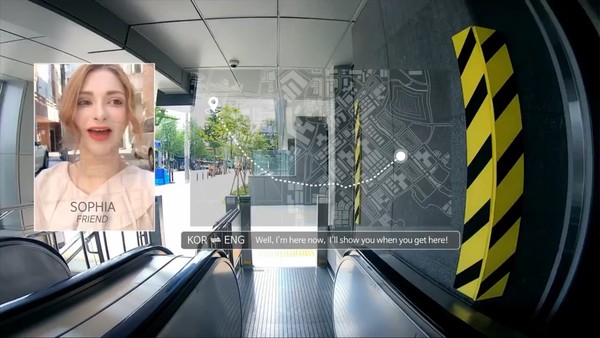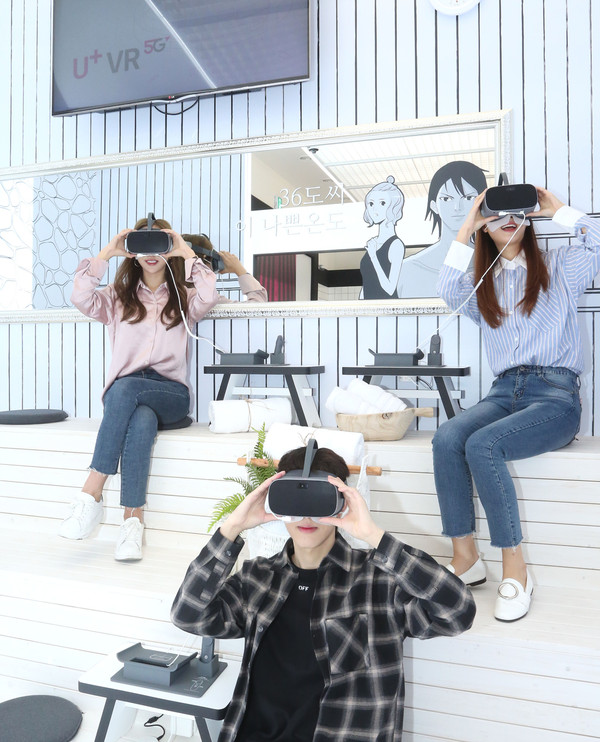By Jeon Seung-min WIRED Korea
A woman, a tour guide, is smiling at me. She is so close to me that I can touch her if I extend my arm. She is walking with me in a Liverpool back alley. She is talking about all the memorable places in the maritime city in northwestern England.
As I poke about here and there, I see people pass by. I can hear them talk. I can also hear the faint sound of winds when I gaze at a tourist attraction. Now I am taken by surprise when a vehicle honked behind me. When I look back, I see a black taxi rushing by me.

What I saw and heard a moment ago was not a real reality but a virtual one. But it was so vivid that I said with an exclamation, “That’s terrific!” The footage on Liverpool was one of the VR contents provided on the 5G mobile networks in Korea.
When I took off the headset, I came back from the virtual reality and saw where Korea’s 5G services were standing as a reporter covering the ICT industry.
Korea, which had maintained a policy of following first movers in almost all industrial sectors, took an exception when it came to wireless telecommunication. It was nothing short of a bold move when it decided to take the lead in commercializing 5G network technology – a cutting-edge telecommunication technology that is characterized by ultra-high speed, ultra-low latency and massive connectivity.
But not many mobile subscribers had hopped off LTE and jumped on to 5G since the three Korean network service providers started 5G commercial services in April 2019. The reasons were the high subscription rate and the paucity of contents.
Going beyond the Reality
But the outlook is now changing for the better, as the mobile carriers are stocking up on high-quality contents, promising to “go beyond the reality” in their provision of contents ranging from imageries and games to sports.
For a spot check, this reporter visited an experience pavilion housed in the headquarters of LG Uplus, one of the three Korean 5G network carriers, in Yongsan-gu, Seoul, on December 10. Visitors were allowed to try all the contents provided on the LG Uplus’ 5G network.

What he confirmed at the LG pavilion was 5G is nearer to us than he thought. Subscribers can get access to a variety of three-dimensional (3D) VR contents and obtain diverse information with the use of augmented-reality service. When I put a 5G-supported smartphone into a headset and wore it, I was able to look at the 3D imagery of the content, which was being streamed via the LG Uplus network.
Many of the contents in stock were those of travel, leisure and sports designed for immersive VR experience. You may look around a tourist attraction with a celebrity entertainer or a renowned fashion model. Or, you may scuba-dive and swim along with a school of colorful tropical fish.
“Ultra-high speed is needed for this VR service, which is provided only to 5G service subscribers owning a headset,” said an LG Uplus official manning the pavilion. “Many of the visitors ask about the 5G subscription rate.”
The “U+AR” imagery is another vaunted content provided by LG Uplus. You can be video-taped to show the virtual reality of dancing with an entertainer. You may choose to dance in any place of your choice – in front of, behind, alongside or even on the shoulder of the VR entertainer.
Also of keen interest to visitors are those contents designed to teach modern dance, ballet and sports. Learners may put themselves alongside virtual instructors and watch themselves as they try over and over again to take steps, move their body or hit the ball in the way the virtual instructor does.
The 5G technology makes possible a different way to televise sports games. In a departure from conventional telecasting, the network carriers now make it possible, for instance, to choose to view a hitter touching the first base or a runner starting from the third base. The catcher on the home base can be seen in 360 degrees. This kind of service is made possible as all data from the 60 cameras installed in the Jamsil Baseball Stadium is transferred to the phone with no delay. It is the same with other sports games. For instance, golf fans may follow their favorite players, with cameras installed at each of the 18 holes.
Gamers will undoubtedly feel rewarded when they start playing games on the 5G network. They start a game immediately, instead of waiting until a large of amount of game data is downloaded as they have done in the past. LG Uplus has started the GeFroce Now service, providing games with movie-quality graphics in collaboration with the Nvidia, a global leader in the game industry.
Concentration on Selected Services
The three 5G mobile carriers, which have many similar services, are focusing on areas where they believe they have comparative advantages.
SKT, another Korean mobile carrier, which has the largest number of 5G subscribers, is concentrating on what it regards as sharing via VR. It says it is building a virtual social world, in which many people meet with each other, share their experiences and build friendships and enjoy contents together.
For instance, its subscribers are able to root for its team of professional gamers, T1, together when they watch the League of Legends games, have their avatars dance together in a club or performance hall or attend an English conversation class.
For its part, KT is concentrating on upgrading its existing services. For instance, the network carrier has come up with an improved music service, Drop the Beat, which its subsidiary, Genie Music, developed for the provision of music of 24-bit-ultra-high quality. It has also improved its videotelephony for vivid imagery.
On the other hand, LG Uplus is all out to stock VR and AR contents. It is planning to expand its archives to include more than 15,000 titles. In this vein, it has secured investments from two VR companies – VentaVR of Korea and Amaze VR of the United States.
At the 5G Vertical Summit held at Seoul Plaza Hotel on December 3, Sohn Min-seon, a senior manager at LG Uplus, said her company is focusing on producing contents with 3D 360-degree imagery to give a greater sense of reality to its subscribers. That, she said, was an answer to a question why 5G services are needed when Netflix and YouTube are providing high-quality contents on the LTE platform.
Beyond the Virtual World
True, the mobile carriers are expanding their 5G services, with their contents being mostly for video ranging from VR and AR to games. But these are only a small fraction of what 5G technology promises. It will produce greater value when it is used to improve the social infrastructure.
Transformation is in store for so many sectors of the society. Transportation is one such area, with self-driving vehicles and roads without traffic lights being made possible by 5G technology with ultra-high speed. And 5G-enabled Internet of Things will usher in an era of smart factories. It is also possible to operate airliners, oceangoing ships and construction equipment at a place thousands of kilometers away from them.
Research is extensively conducted for the use of 5G technology in infrastructure improvements. SKT, for instance, reported on November 21 that it had successfully completed a research project of building a road by remote control, together with the Korea Institute of Construction Technology, Trimble, Hyundai Construction Equipment and SK Engineering and Construction.
The participating researchers and engineers were able to complete a pilot project of building a 260-meter-long and 20-meter-wide road section in a period of 37 days with the use of a LiDar device, drones and AR technology in the entire process of topographical measurement, designing, construction and management. They are planning to conduct a feasibility study of an entire road.
In a similar research project, LG Uplus successfully remote-controlled the operation of an excavator in Munich, Germany, from Incheon, with the distance between the two places measured at 8,500km. The work was made possible with 5G technology’s ultra-low latency, among others.
Ulrich Dropmann, chief technology officer of Nokia Bell Labs, said that wireless communication is gaining greater importance in industry as well and that 5G technology will be put to use in various industrial sectors, including factories and mines where safety and productivity are put before anything else.
※The above is a translation of Seung-min Jeon’s Korean-language article by Nam-Hyun Choi, deputy editor in chief at WIRED Korea.


 뉴스레터 신청
뉴스레터 신청